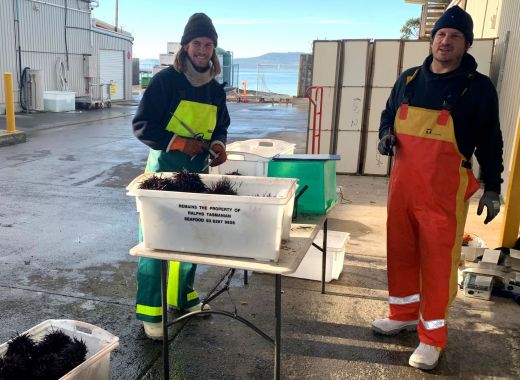
Institute for Marine and Antarctic Studies (IMAS) researchers have produced the first scientific assessment of Tasmania's growing long-spined sea urchin fishery.
The expansion of the commercial fishery is one of a number of measures addressing growth in the population of invasive sea urchin Centrostephanus rodgersii and the barrens they create by overgrazing reefs along Tasmania's East Coast.
A single long-spined urchin was found in St Helens in 1978, and since then the Tasmanian population has grown to an estimated 20 million, with an average increase between 2000 and 2017 of more than 150 tonnes per annum.
The lead author of the fishery assessment for the 2018/19 season, Dr Katie Cresswell, said the report showed that the annual catch had increased five-fold since harvesting began in 2009.
"The annual catch remained below 100 tonnes for many years but ramped up after 2017, reaching 185 tonnes in 2018," Dr Cresswell said.
"The catch increased further in 2019 to 560 tonnes and this fishery is now the third-largest in Tasmania per wet tonnage harvested.
"The catch has been spatially concentrated, with 80-90% of the urchin harvest coming from a small area of the East Coast around the St Helens region.
"While harvesting for the entire coast is sustainable despite the increases in total catch, there is evidence of stock reduction in the most heavily fished areas over time.
"This suggests that, for the more heavily fished areas, catch rates will fall, which will create an incentive for divers to move southward down the coast.
"The effect of divers shifting to new areas means that we won't necessarily see sharp declines in catch rates if high levels of harvest continue to occur," Dr Cresswell said.
Co-author Professor Caleb Gardner said that when partial data for the current season is included, over the last three seasons the annual catch has exceeded the average increase in long-spined sea urchin biomass of around 150 tonnes per annum.
"Commercial harvesting is one of a number of actions taken to reduce the number of these invasive urchins, with most interventions based on IMAS research and supported by the State Government and the Tasmanian Abalone Council under the Abalone Industry Reinvestment Fund (AIRF)," Professor Gardner said.
"Other measures underway that will assist in controlling urchin numbers include the rebuilding of lobster stocks, culling of urchins, and investigation of potential uses for urchin waste in industries such as agriculture," he said.
Pictured: IMAS's Paul Armstrong and Stuart Isles collect data at Ralph's Tasmanian Seafood, Electrona.






